Employee Information Form Samples
-
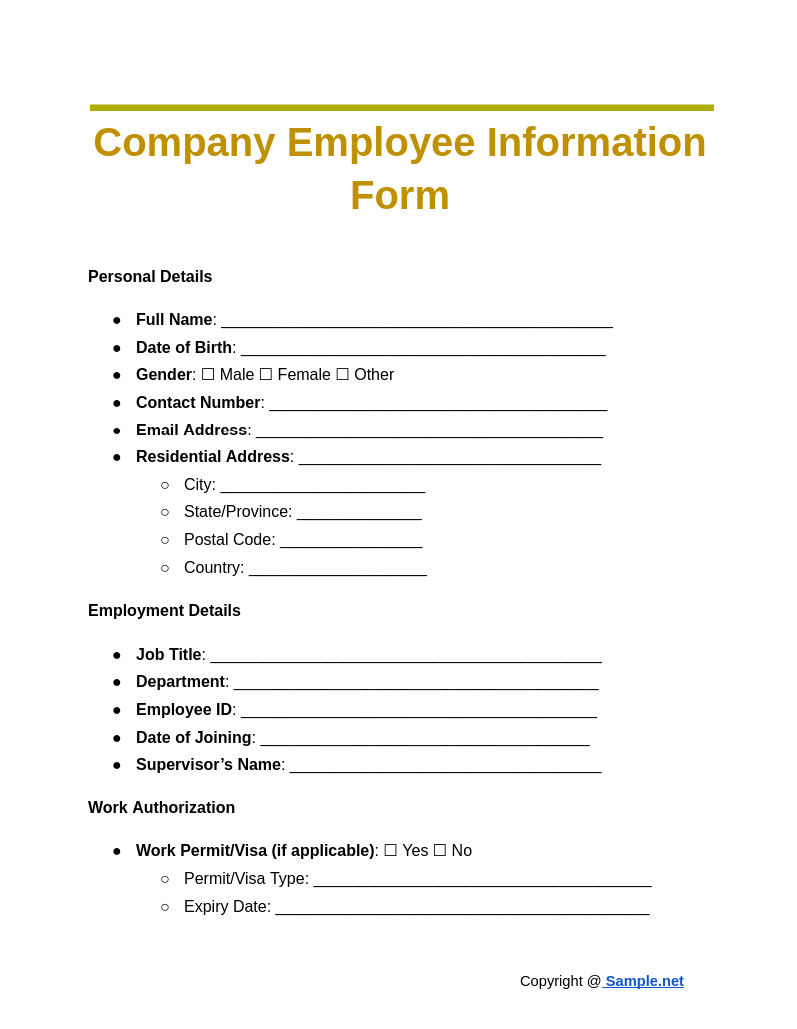
Company Employee Information Form
download now -
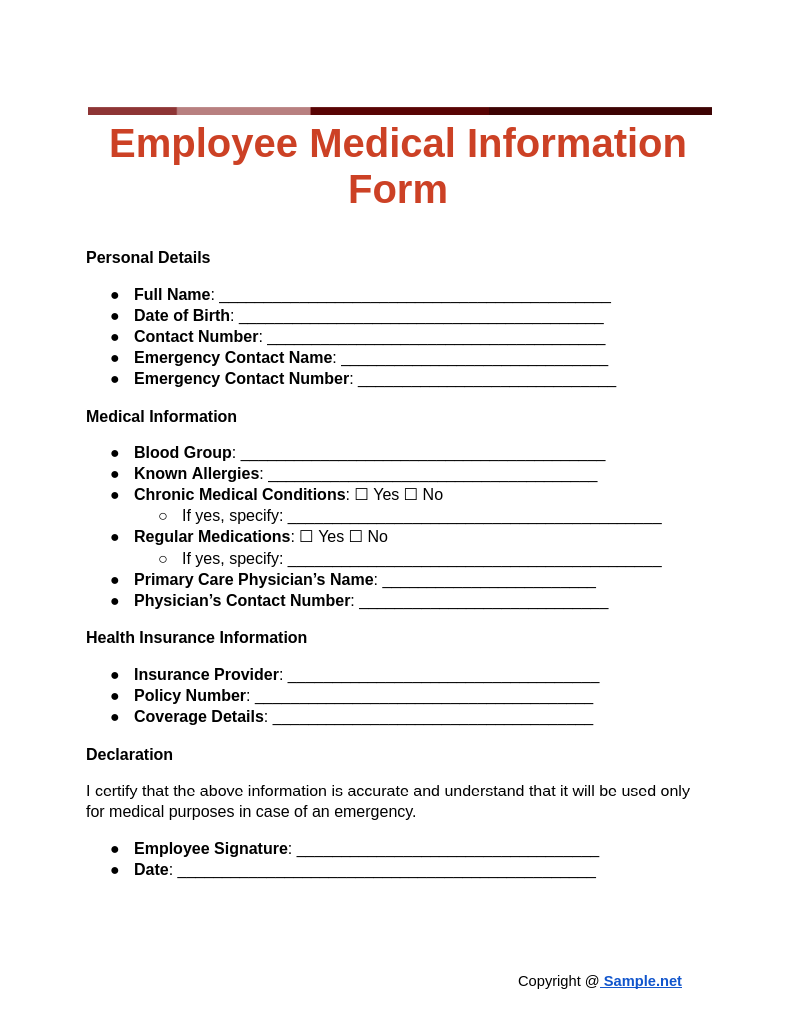
Employee Medical Information Form
download now -
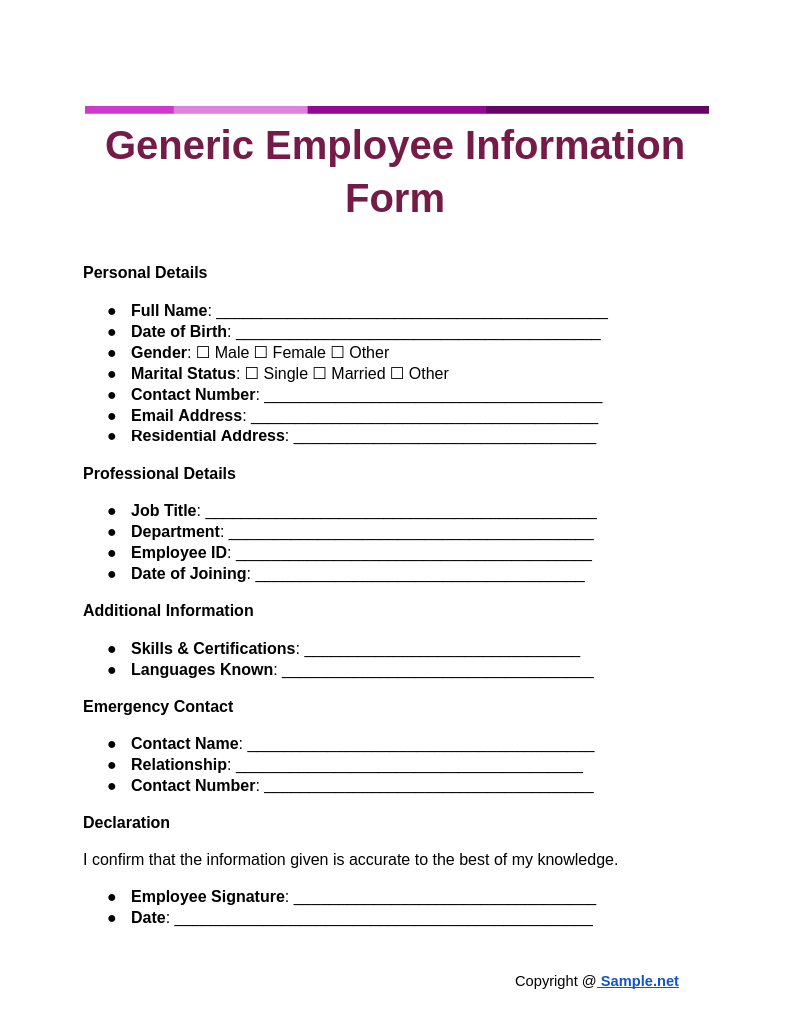
Generic Employee Information Form
download now -
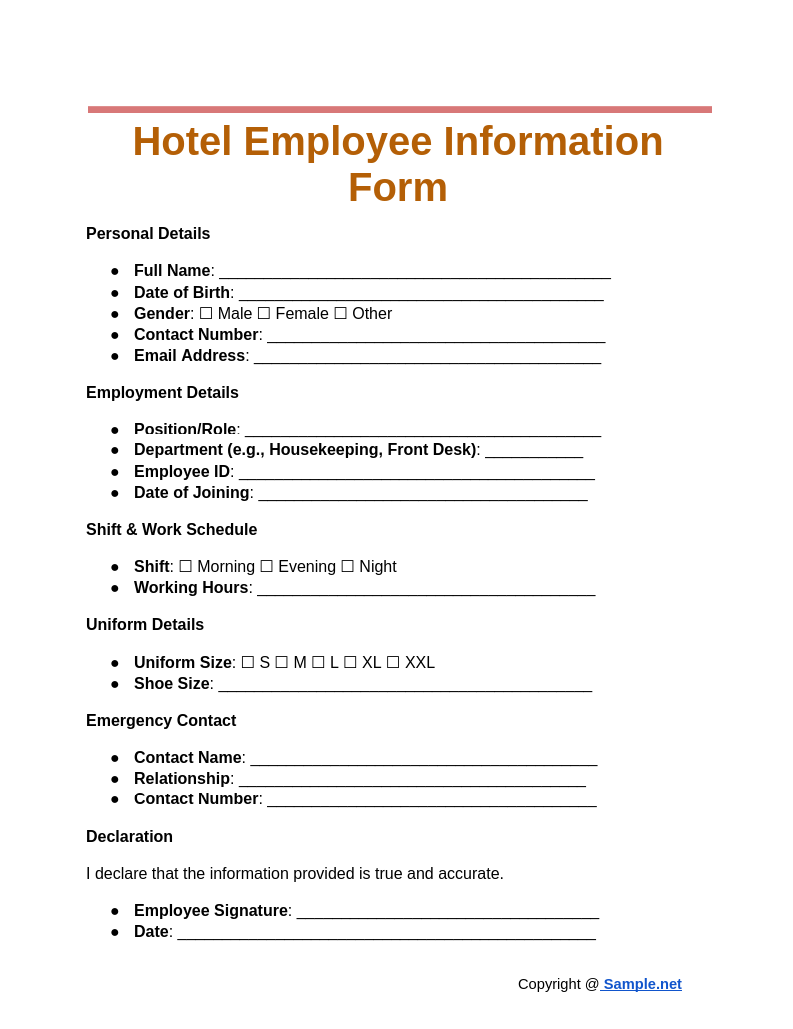
Hotel Employee Information Form
download now -
FREE Employee Information Form s to Download
Employee Information Form Format
Employee Information Form Samples
42+ Sample Employee Information Forms
What is an Employee Information Form?
Importance of an Employee Information Form
What to Include in an Employee Information Form: A Checklist
How to Respectfully Gather Employee Information
FAQs
Why should I fill out an employee information form?
How do I collect employee information?
What’s the best way to store an employee information file?
Should sensitive information be included in an employee information form?
What’s the difference between personal information and sensitive information?
Can the Employee Information Form be digital?
How does an Employee Information Form help in compliance?
What are the challenges in maintaining Employee Information Forms?
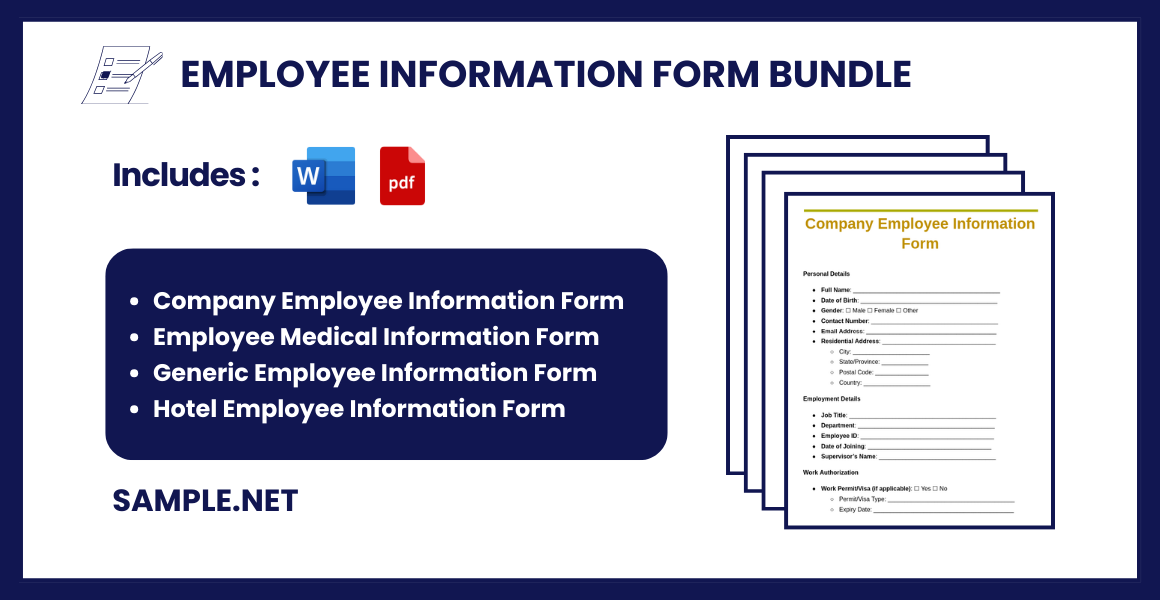
Download Employee Information Form Bundle
Employee Information Form Format
Personal Details
- Full Name: ____________________________________________
- Date of Birth: _________________________________________
- Gender: ☐ Male ☐ Female ☐ Other
- Marital Status: ☐ Single ☐ Married ☐ Other
- Nationality: __________________________________________
- Contact Number: ______________________________________
- Email Address: _______________________________________
- Residential Address: __________________________________
- City: _______________________
- State/Province: ______________
- Postal Code: ________________
- Country: ____________________
Employment Details
- Position/Job Title: ___________________________________
- Department: _________________________________________
- Employee ID: ________________________________________
- Date of Joining: _____________________________________
- Work Location: ______________________________________
Emergency Contact Information
- Contact Name: _______________________________________
- Relationship: _______________________________________
- Contact Number: _____________________________________
- Alternative Contact Number: __________________________
Bank Account Details
- Bank Name: _________________________________________
- Account Holder’s Name: ______________________________
- Account Number: ____________________________________
- IFSC Code (if applicable): ___________________________
- Branch Address: ____________________________________
Previous Employment Details (if applicable)
- Last Company Name: ________________________________
- Last Position Held: __________________________________
- Duration of Employment: _____________________________
- Reason for Leaving: __________________________________
Additional Information
- Skills: _____________________________________________
- Languages Spoken: __________________________________
- Hobbies/Interests: ___________________________________
- Any Disabilities: ☐ Yes ☐ No
Declaration
I hereby declare that all the information provided above is true and correct to the best of my knowledge.
- Employee Signature: __________________________________
- Date: _______________________________________________
42+ Sample Employee Information Forms
-
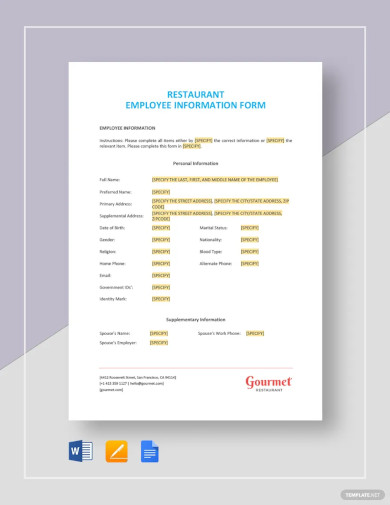
Restaurant Employee Information Form Template
download now -
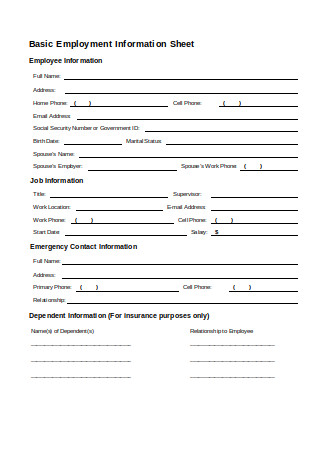
Employee Information Form
download now -
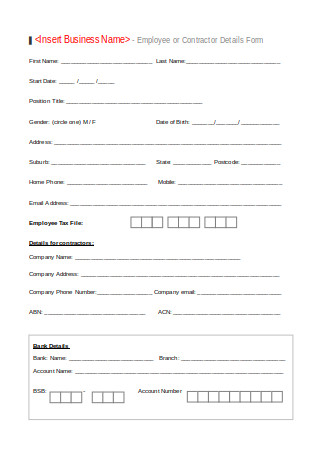
Employee Details Form
download now -
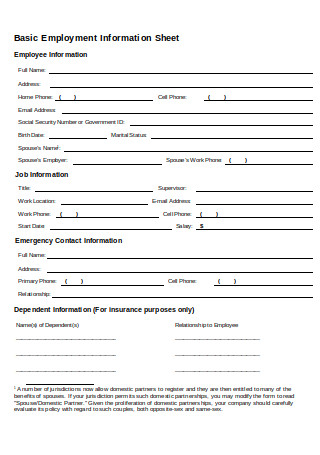
Basic Employment Information Form
download now -
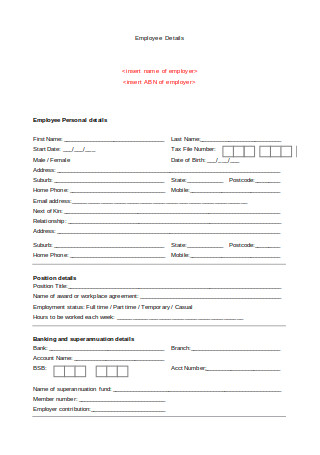
Employee Small Business Information Form
download now -

Employment Record Information Form
download now -
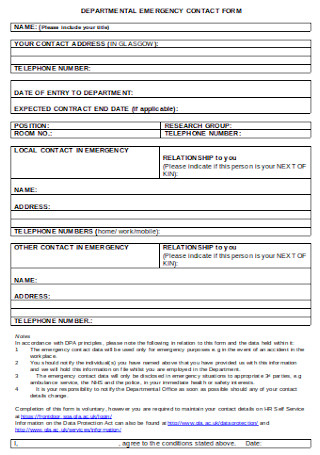
Employee Personnel Record Information Form
download now -
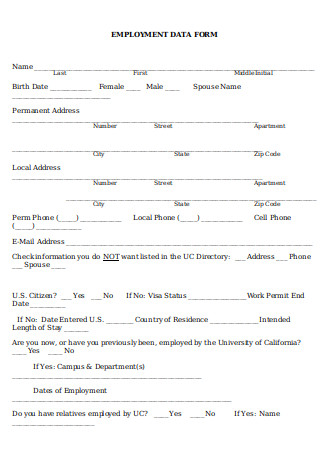
Sample Employee Information Sheet Form
download now -
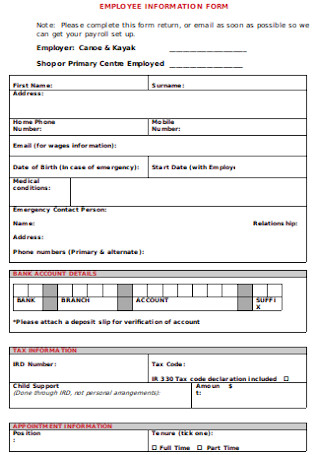
Basic Employee Information Form
download now -
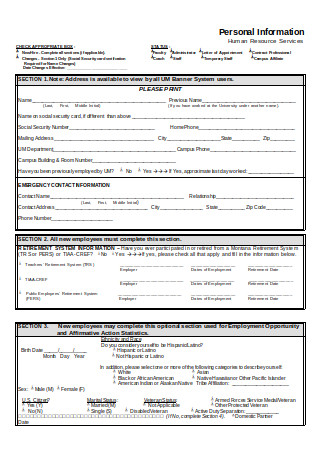
Personal DataSheet of Employee Information Form
download now -
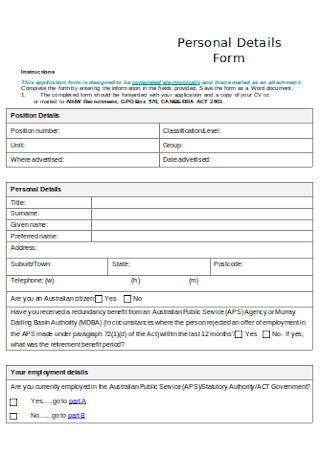
Sample Personal Employee Details Form
download now -
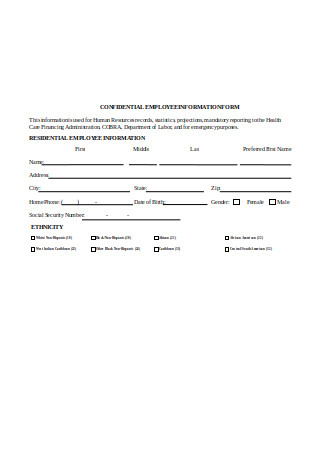
Confidential Employee Information Form
download now -
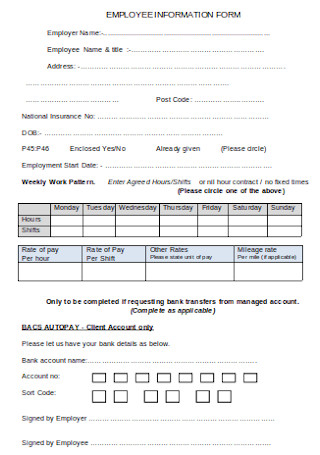
Editable Employee Information Form
download now -
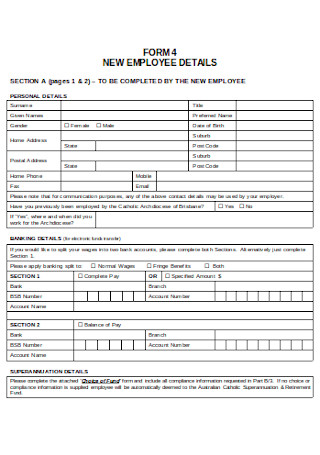
New Employee Details Form
download now -
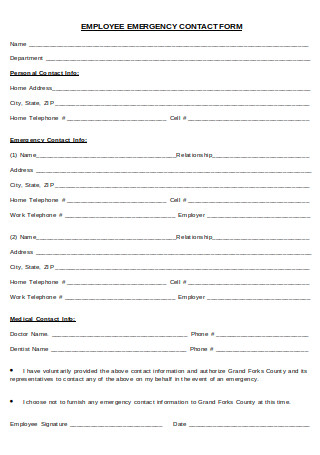
Employee and Emergency Contact Information Form
download now -
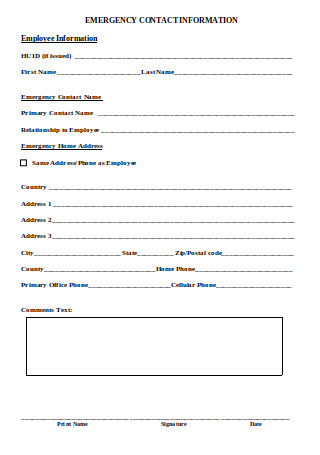
Employee Emergency Contact Information Form
download now -

Emergency Contact Details Form for New Employees
download now -
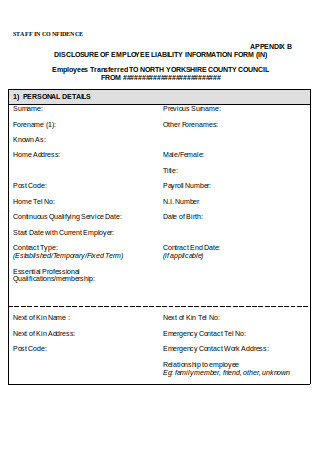
Sample Employee Liability Information Form
download now -
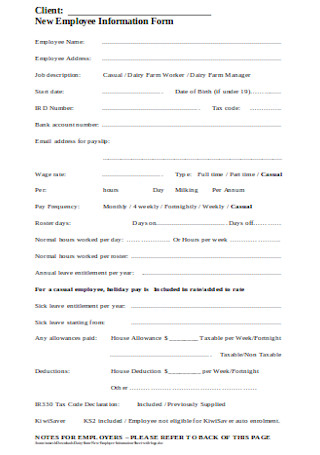
New Employee Information Form
download now -
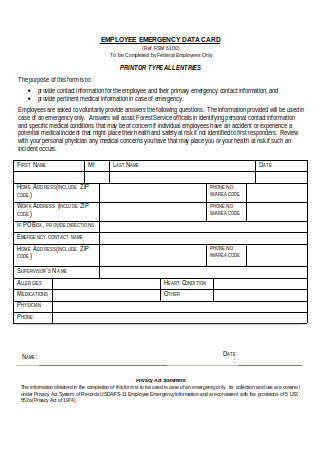
Sample Emergency Information Form
download now -
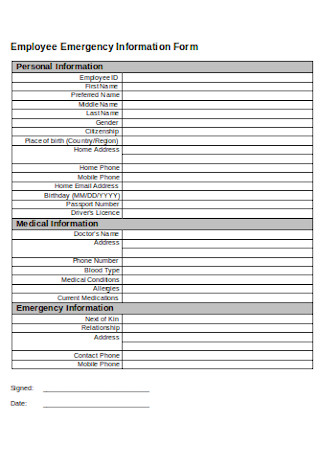
Employee Emergency Information Form
download now -
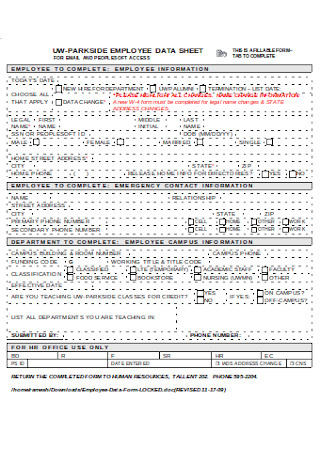
Employee Data Form
download now -
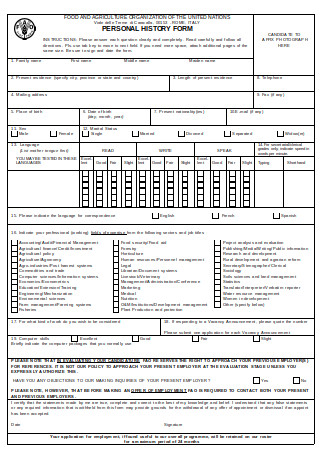
Personal History Form
download now -
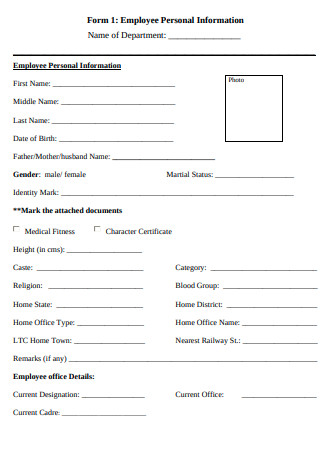
Employee Personal Information
download now -
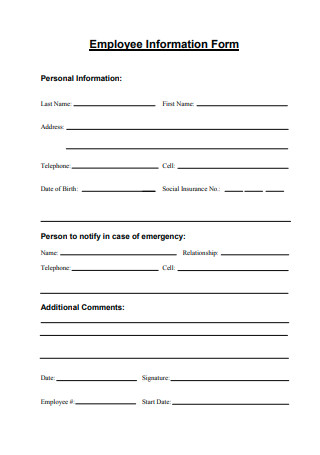
Employee Information Form Sample
download now -
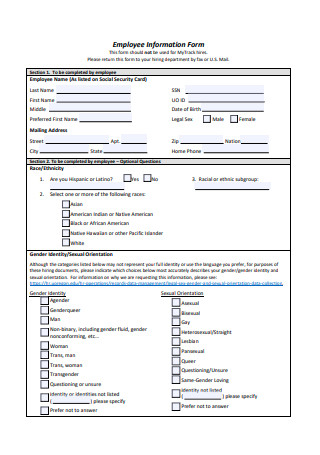
Printable Employee Information Form
download now -
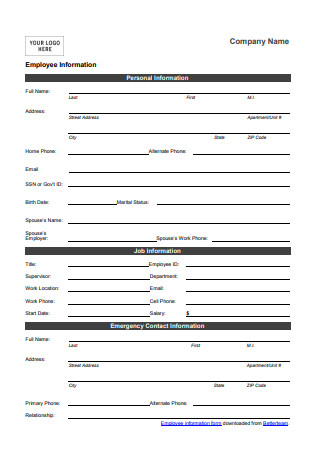
Personal Information Form of Emplooyee
download now -

New Employee Information Form Template
download now -

Simple Employee Information Form Example
download now -
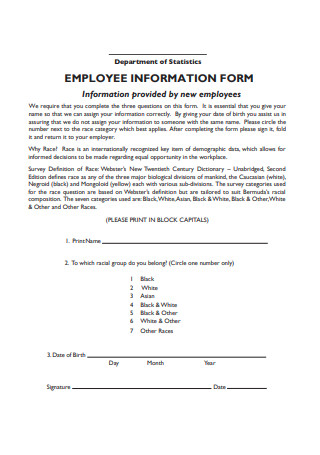
Revised Employee Information Form
download now -
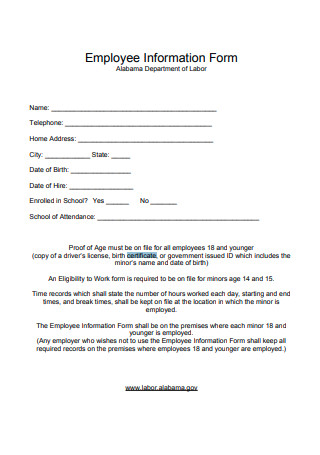
Simple Employee Information Form
download now -
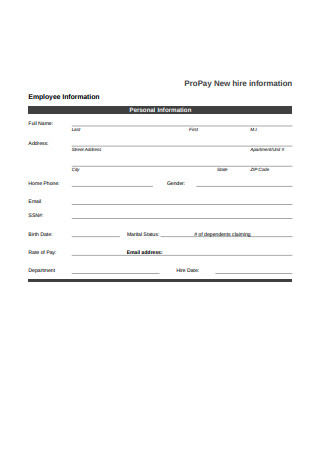
New Employee Hire Information
download now -
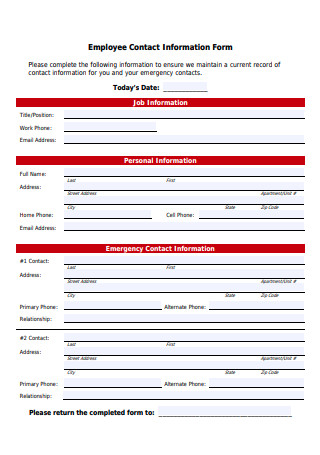
Employee Contact Information Form
download now -
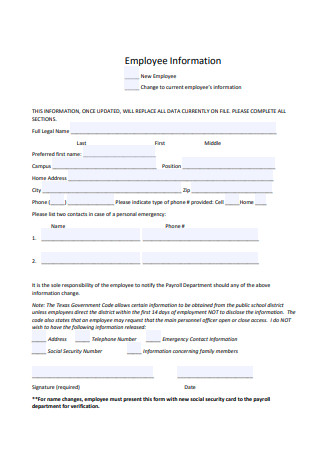
Employee Information Form Sample
download now -
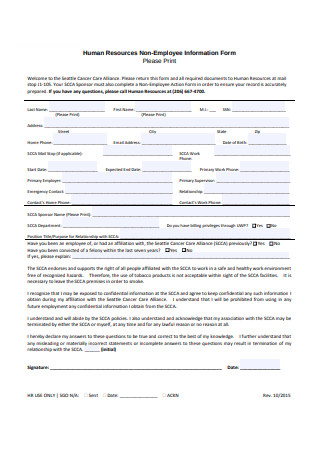
HR Non-Employee Information Form
download now -
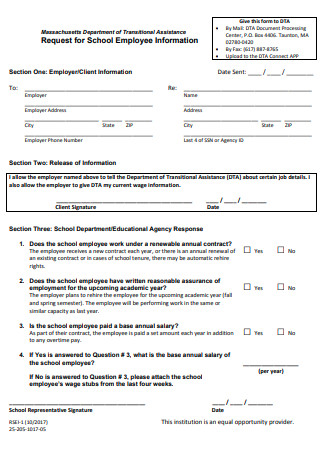
School Employee Information Form
download now -
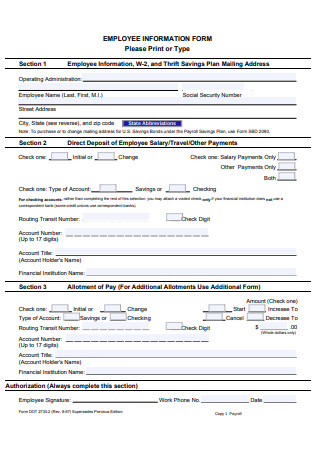
Standard Employee Information Form
download now -
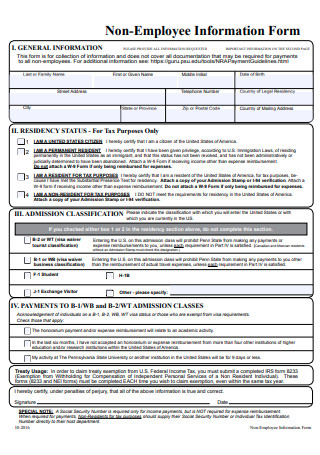
Non-Employee Information Form
download now -

Employee Information Change Form
download now -
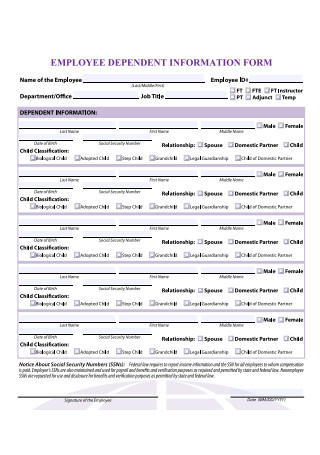
Employee Dependent Information Form
download now -
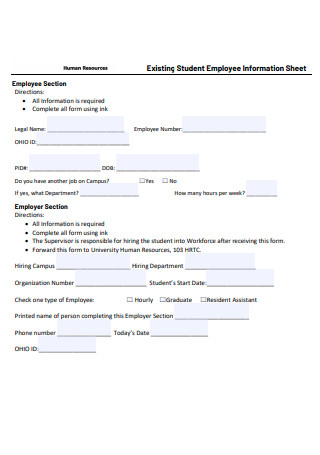
Student Employee Information Sheet
download now -
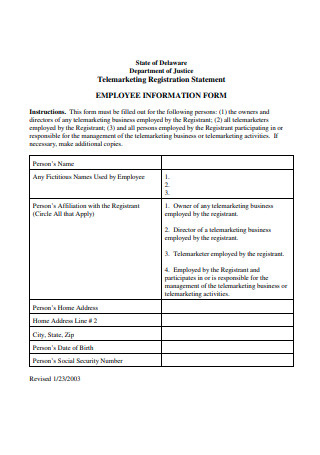
Employee Information Form in PDF
download now
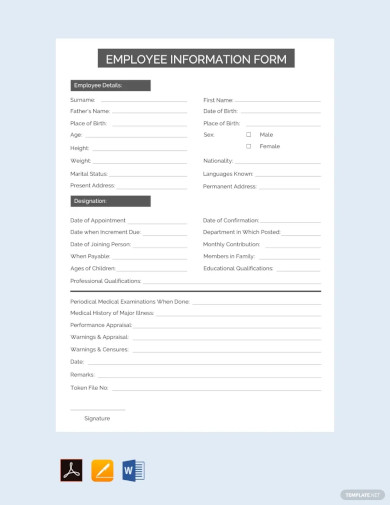
Employee Information Form Template
download nowWhat is an Employee Information Form?
It is standard in every company to establish a record-keeping system containing vital employee information. Can you imagine not knowing anything about the people working for you?—that wouldn’t be a good look. The key to managing a successful business plan is knowing your workforce and having a legitimate concern for their being. Hence, it is essential to have incoming employees and even existing ones fill out an employee information form. An employee information form contains basic details on employees. This information can be classified into three parts: personal information, employment information, and emergency contact details. By having this document on hand, you can easily identify the people working for you. You can also see more on New Employee Form.
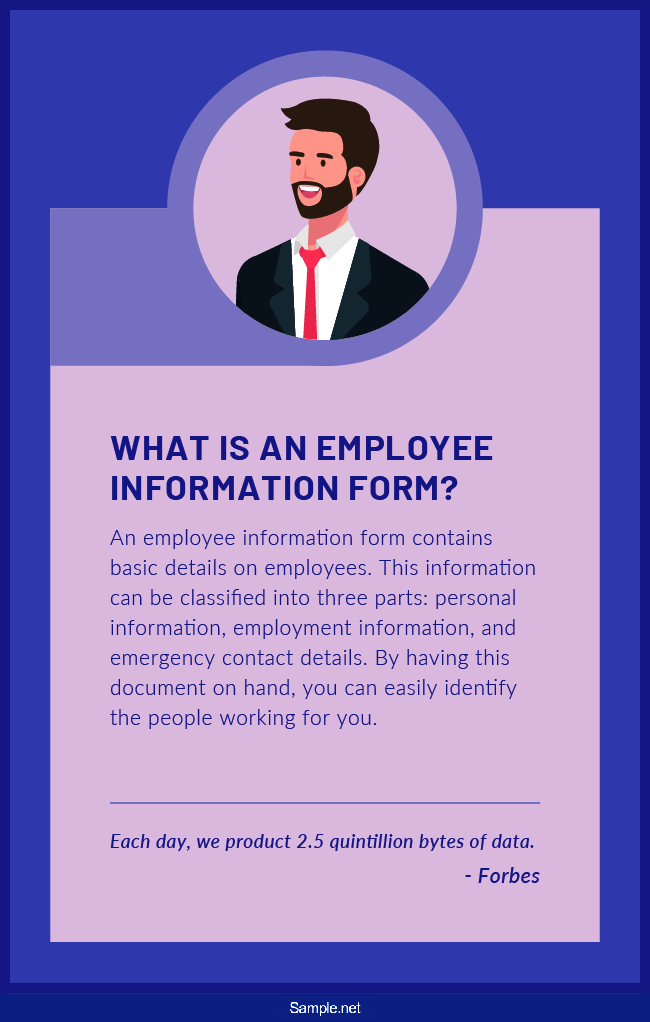
Importance of an Employee Information Form
In this age, information plays a significant role in the Employee development plan of business industries. We need to stay updated with statistics and facts to survive and be relevant. This includes basic information about our employees. Starting from the job application phase, you already have to ask potential employees a few essential questions such as their full name, age, educational background, past work experiences, and even their expectations. All these facts constitute information. The data gathering process doesn’t stop from there, it continues even after official employment. You can ask your personnel additional crucial information such as the name of his or her spouse and how you will be able to reach him or her in the event of an emergency. You may also collect information about your employee’s health and medical history should the need arise. Keep the records secured once you’re satisfied with everything that you’ve gathered. You can use them as future reference.
What to Include in an Employee Information Form: A Checklist
Federal and state laws provide some restrictions on what you can and cannot ask potential and existing employees. Mostly, questions that would cause discrimination and hate towards a person are prohibited, these include inquiring into an individual’s race, color, religion, sex (including gender identity and sexual orientation), physical and mental disability, and even his political views. To help you avoid future legal issues in the employee data gathering process, below is a checklist of basic personal information you can include in your company employee information form. You can also see more on HR Form.
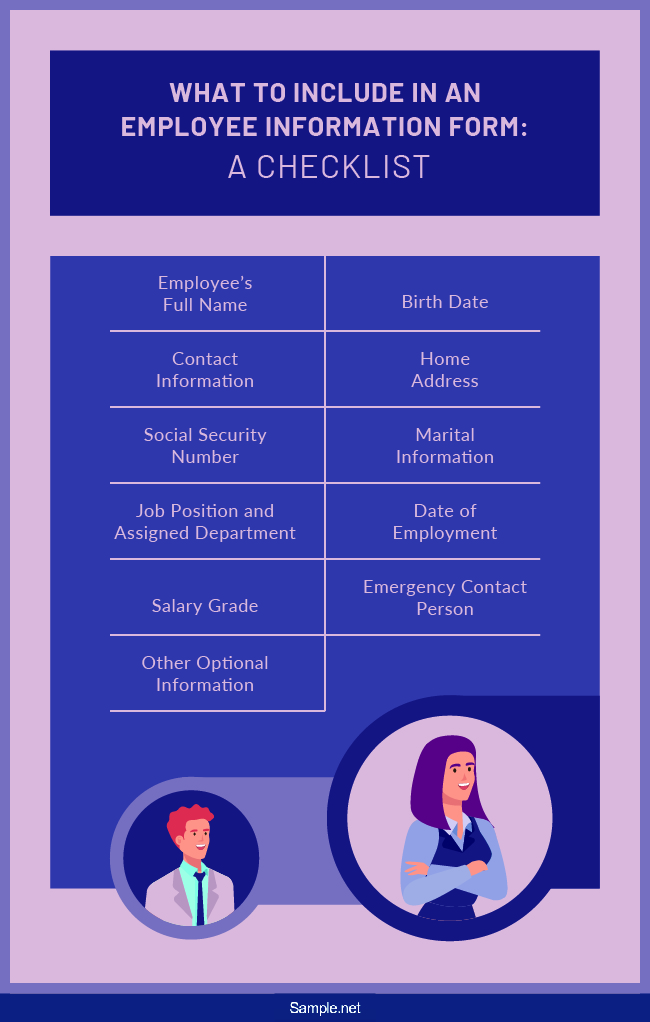
How to Respectfully Gather Employee Information
Data gathering and collection are inevitable in the business world. Information is handed to you at all angles. Sometimes you’re the one who needs to gather it. As reported by Forbes, we produce approximately 2.5 quintillion bytes of data each day, unfathomable. Employee information contributes to those numbers. You can also see more on Request Forms. When asking employees for their information, here are some guides you should take note:
Step 1: Know when to gather the information
Ideally, an employer should only gather basic personal information during the pre-employment stage. There’s a fine line between what information you can and cannot ask a potential employee. Think of it as you’re meeting a person for the first time, and you’re doing small talks, only ask basic questions—his name, age, address, and contact information. You can even further ask his educational background and his accomplishments. Once you’ve surpassed the small talk phase and he is officially an employee, you have the right to ask for additional required information; for example, his social security number, emergency contact details, spouse information, and health details. You can also see more on Employee Write Up Forms.
Step 2: Know what information to ask
There are existing laws that mandate an employer to gather specific employee information. According to the Internal Revenue Service (IRS) website, an employer needs to secure the following information from his employees: eligibility to work in the United States, employee’s social security number (SSN), and an employee’s withholding. There are also instances where the law prohibits the gathering of sensitive information that would cause discrimination to an employee, such as his political views, religion, or cultural background.
Step 3: Be transparent about the purpose
In this age, where data collection is a business industry, you would feel uneasy if someone is gathering your personal information, especially when they are not clearly stating the purpose of the inquiry. That’s why you need to be honest with your employees and give them the reason for the data collection. It can either be to follow the mandate of the law, to process his health insurance receipt, or for health and safety purposes.
Step 4: Establish confidentiality
A non-disclosure agreement policy in an employment relationship is not one-way. An employee promises to keep as secret all confidential company data that comes to his possession, while the company promises to safeguard personal information handed to it by its employee. As human resource personnel, the company is entrusting you to manage and keep all employee information secured. Make sure to be careful when handling sensitive data to avoid facing future lawsuits.
Step 5: Determine the data collection method
The most effective and accurate method of request for information gathering is by handing fill-out forms to your employees. You can browse through our numerous readily printable and editable sample templates and download the one most suitable for you. You can choose to have the file in PDF or DOC format.
Step 6: Securely store the information
A preferred way of storing information is through electronic means. You can set up a google drive to secure the storage of important documents and forms. If you don’t trust third-party applications such as Google Drive, you can choose to put all files in a secured hard drive. But be sure to have a copy as a back-up in case you’ll lose all data in the primary drive. You can also go old-school and manually store all company files in a file cabinet. You can also see more on Employee Verification.
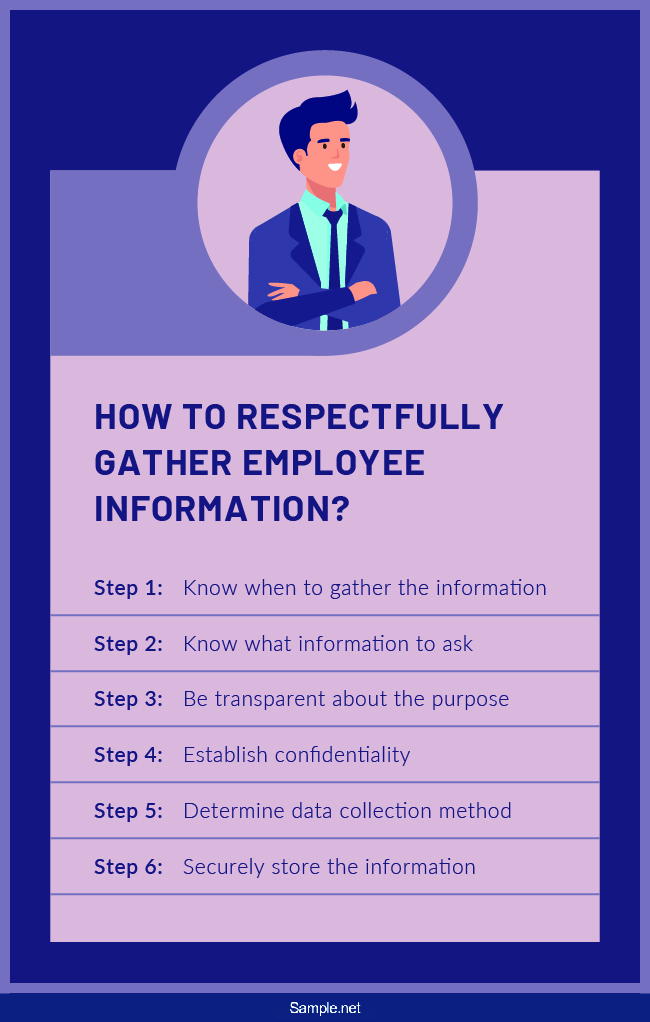
Data gathering can be difficult and complicated. There are a lot of things to consider like what to ask and what not. Asking a single question can cause legal issues, that’s why it’s important to do your research on existing privacy laws. When creating an employee information form make sure to consider everything we’ve discussed. To make your life easier, you can download a pre-made form on this page. You can also see more on Exit Interview Forms.
FAQs
Why should I fill out an employee information form?
If you’re an employee, filling out an employee information form can be beneficial to you. The form contains the contact information of your immediate family member. In the event of any serious workplace injury, your employer can call your emergency contact for you. you can check Workplace Emergency Action Plan.
How do I collect employee information?
You can be upfront about the collection. The most straightforward method is to provide your employees with a fill-out data form. It should contain the information you need. Another option is to dig in employee records. During the hiring process, we usually have potential employees filling out an information sheet. You can use already existing information such as the previous-mentioned.
What’s the best way to store an employee information file?
A considerable part of an HR employee’s work is organizing mountains of documents. There are two ways you can store company records; you can save it electronically in a computer or hard drive or manually by keeping hard copies in file drawers. Remember to keep confidential data in a secure location. Only grant access to them when the requester has a legitimate purpose.
Should sensitive information be included in an employee information form?
Yes, you can include sensitive information. However, the company must take measures to safeguard employee information; otherwise, they will be held liable under existing privacy and data protection laws. If you work as an HR in a company, you need to determine what information is confidential. You are obligated to keep it stored in a safe place, restrict access to it, and discard it properly. You can also see more on Vacation Request Forms.
What’s the difference between personal information and sensitive information?
Personal information is any information that can directly identify a person such as full name, nickname, home address, birth date, email address, and bank account details. On the other hand, sensitive information is a type of personal information classified as confidential. It can be facts or collection of data when disclosed to the public, causes harm and discrimination to the individual it refers to—for example, a person’s religion, ethnic and cultural background, and his political beliefs.
Can the Employee Information Form be digital?
Yes, many organizations use digital forms to simplify data collection and storage. Digital forms also improve data security and make updating information easier. You can also see more on Payroll Change Forms.
How does an Employee Information Form help in compliance?
It ensures all employee details are documented, aiding compliance with labor laws, tax regulations, and data protection laws. This helps avoid legal complications.
What are the challenges in maintaining Employee Information Forms?
Challenges include ensuring data accuracy, regular updates, privacy protection, and secure storage. Organizations must have clear protocols for managing these challenges. You can also see more on Employee Vacation Request Forms.
